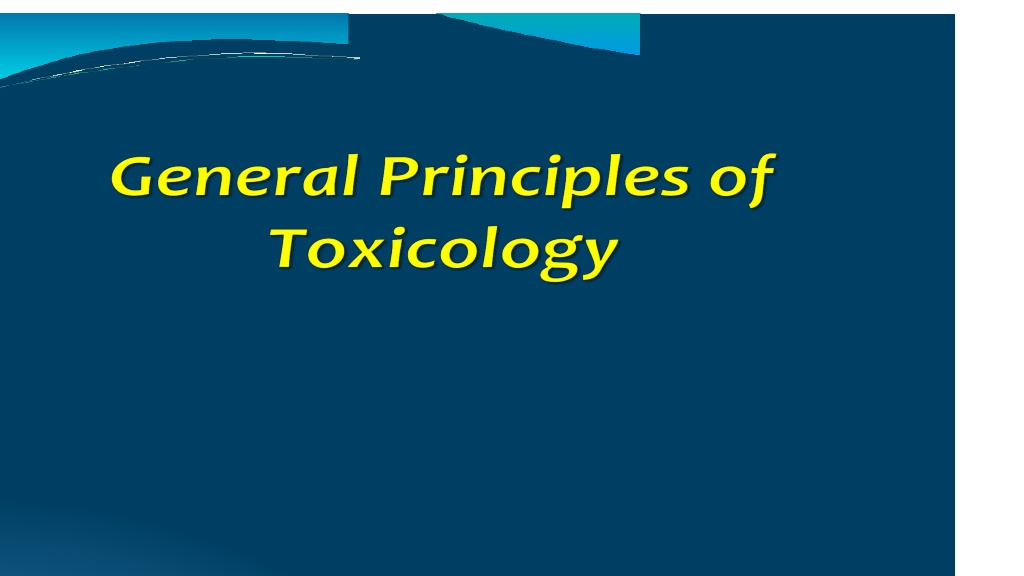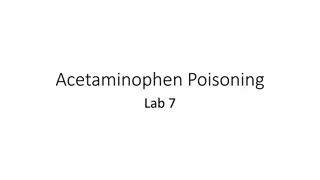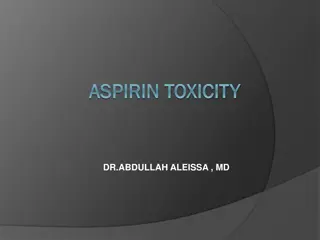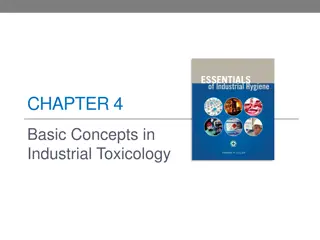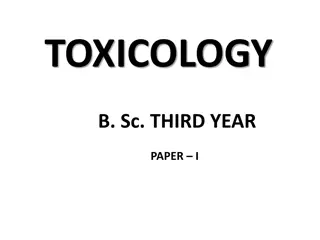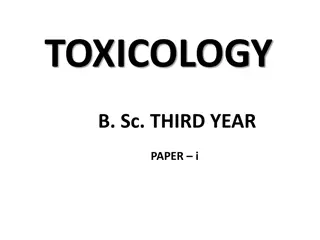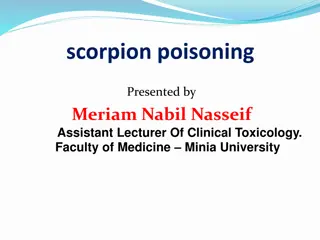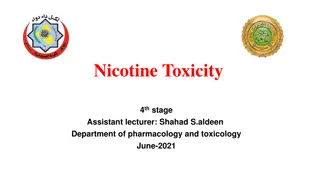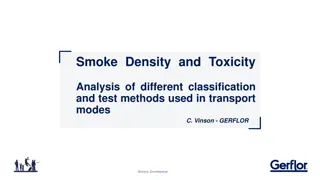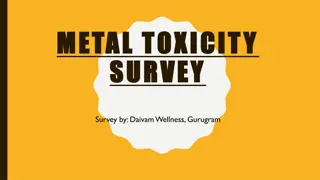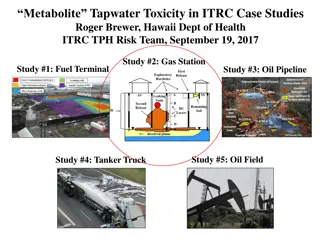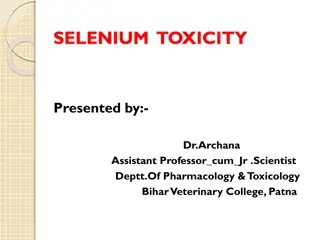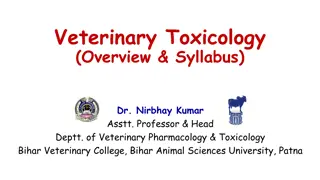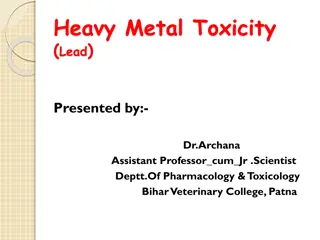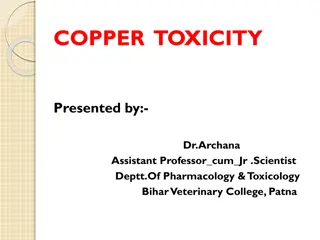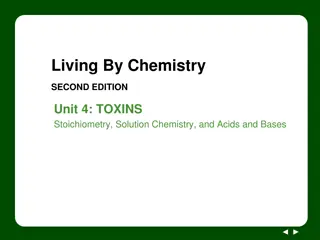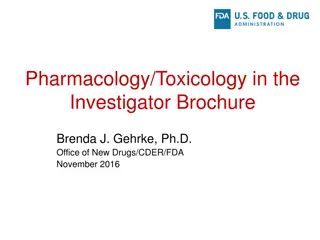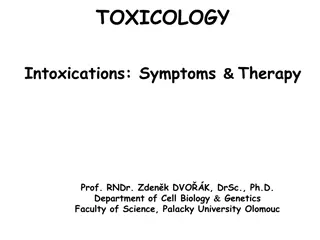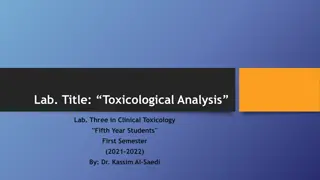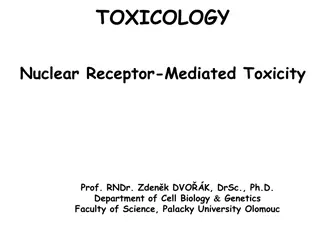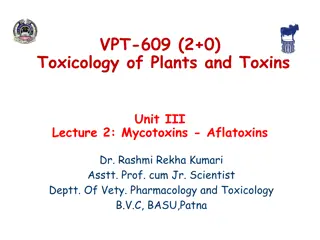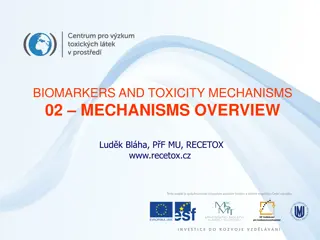Toxicology and Measures of Toxicity
Toxicology is the study of the adverse effects of chemicals on living organisms, involving xenobiotics and poisonous substances. Toxicologists examine the nature of these effects, testing in lab animals for measures of toxicity such as mortality, teratogenicity, carcinogenicity, and mutagenicity. Key measures include LD50 and LC50, assessing the lethal effects of chemicals. Exposure, determined by route, frequency, and duration, plays a critical role in toxicology studies.
Download Presentation

Please find below an Image/Link to download the presentation.
The content on the website is provided AS IS for your information and personal use only. It may not be sold, licensed, or shared on other websites without obtaining consent from the author. Download presentation by click this link. If you encounter any issues during the download, it is possible that the publisher has removed the file from their server.
E N D
Presentation Transcript
Toxicology is the study of the adverse effects of chemicals on living organisms. Xenobiotic - man-made substance and/or produced by plants, animals, or bacteria but not normally found in the body. A toxicologist is trained person to examine the nature of those effects (includingtheir cellular,biochemical,and molecular mechanismsof action)
found in the body. * Poisonous substances are produced by plants, animals, or bacteria. Phytotoxins Zootoxins Bacteriotoxins
Measures of Toxicity Thenormal procedureis toexposetestanimals By ingestion application totheskin Byplacing thetest material in thewaterorairof the test animals environment
testing Lab animals Rats, mice,dogs, monkeysetc Safety inexperimentalanimalsdoes notnecessarily indicatethe same in humans. Example: Thalidomidea human teratogenshows toxicity(caused shortening orcompleteabsenceof limbs) at dosesas lowas 0.5-1 mg/kg and has littleornoeffectin mice orratsatdosesas highas 4000 mg/kg.
Measures of T oxicity Mortality(death) Teratogenicity(abilitytocausebirthdefects) Carcinogenicity(abilitytocausecancer),and, Mutagenicity(abilitytocause heritablechangein theDNA)
Measures of Toxicity: LD50 The amount (dose) of a chemical which produces death in 50% of a population of test animals to which it is administered byanyof avarietyof methods mg/kg Normallyexpressedas milligramsof substanceper kilogramof animal bodyweight
The Median Lethal Concentration LC50 Theconcentrationof achemical inanenvironment (generallyairorwater) which producesdeath in 50%of anexposed populationof testanimals ina specified timeframe mg/L Normallyexpressedas milligramsof substanceper literof airorwater(orasppm)
Theexposure Exposure, like manyof theterms intoxicology, hasseveral differentaspects, the most importantof whichare 1) routeof exposure, 2) frequencyof exposure 3) durationof exposure
Routes and site of Exposure Anagentexerts itseffectswhen itentersorcomes into contactwith the body, orinotherwords, whenan individual has beenexposed to it. 1) Oral GI tract 2) Inhalation Lungs 3) Topical, percutaneous,ordermal Skin 4) Ocular, conjunctiva, cornea Eyes 5) Otherroutes IP , SC, IM, ID, IV ..
Duration and Frequency of Exposure Toxicologists usually divide the exposure of experimental animals to chemicals into four categories: Acute exposure is defined as exposure to a chemical for less than 24 h Subacute exposure refers to repeated exposure to a chemical for 1 month or less Subchronic for 1 to 3 months Chronic for more than 3 months
Dose response The characteristics of exposure and the spectrum of effects Dose response The characteristics of exposure and the spectrum of effects come together in a correlative relationship come together in a correlative relationship customarily referred to as the dose-response relationship Two types Individual to varyingdosesof a chemical,Responseof an individual organism to varying doses of a chemical Populationof individuals customarily referred to as the dose-responserelationship Two types Individualto varyingdosesof a chemical,Responseof an individualorganism to varying doses of a chemical Populationof individuals
LD50 values are the standard for comparison of acute toxicity between chemical compounds and between species TD50 Median Toxic Dose ED50 Median Effective Dose LC50 Median Lethal Concentration
Dose-Response Curve? NOAEL Value No Observed Adverse Effect Level, The highest dose of a chemical that, in a given toxicity test, causes no observable effect in test animals The NOAEL for the most sensitive test species and the most sensitive indicator of toxicity is usually employed for regulatory purposes LOAEL Value Lowest Observed Adverse Effect Level, The lowest dose of a chemical that, in a given toxicity test, does cause an observable effect in test animals
